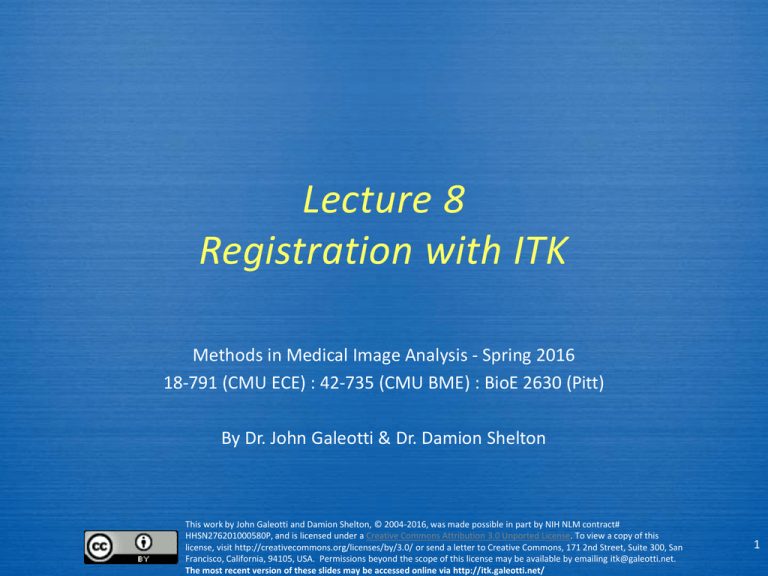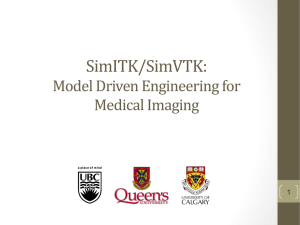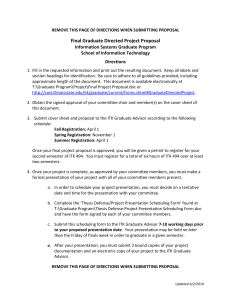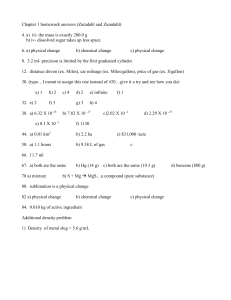ITK Lecture 13: Registration
advertisement

Lecture 8 Registration with ITK Methods in Medical Image Analysis - Spring 2016 18-791 (CMU ECE) : 42-735 (CMU BME) : BioE 2630 (Pitt) By Dr. John Galeotti & Dr. Damion Shelton This work by John Galeotti and Damion Shelton, © 2004-2016, was made possible in part by NIH NLM contract# HHSN276201000580P, and is licensed under a Creative Commons Attribution 3.0 Unported License. To view a copy of this license, visit http://creativecommons.org/licenses/by/3.0/ or send a letter to Creative Commons, 171 2nd Street, Suite 300, San Francisco, California, 94105, USA. Permissions beyond the scope of this license may be available by emailing itk@galeotti.net. The most recent version of these slides may be accessed online via http://itk.galeotti.net/ 1 For more info/gory detail… Please see the following for exhaustive detail: Chapter 3 in the ITK Software Guide Book 2 Insight into Images ITK Source Tree Examples/Registration/ E.g. Examples/Registration/ImageRegistration1.cxx ITK Doxygen http://www.itk.org/Doxygen47/html/group__RegistrationFilters. html http://www.itk.org/Doxygen47/html/group__GroupRegistration.html http://www.itk.org/Doxygen47/html/group__GroupNumerics.html 2 What is registration? The process of aligning a target image to a source image More generally, determining the transform that maps points in the target image to points in the source image 3 Transform types Rigid (rotate, translate) Affine (rigid + scale & shear) Deformable = non-rigid (affine + vector field) Many others 4 Registration in ITK ITK uses an extensible registration framework Various interchangeable classes exist Relatively easy to “twiddle” the part you’re interested in while recycling prior work The new ITKv4 Registration framework is separate from the legacy framework. The legacy framework follows traditional practice Version 4 registration is more flexible and thus more complex Use the v4 framework whenever practical SimpleITK will NOT support registration until v. 0.9 SimpleITK 0.9 beta source code is already available on git For “simple” usage, consider using ANTS instead: http://www.picsl.upenn.edu/ANTS/ 5 New in ITKv4 (ImageRegistrationMethodv4, etc.) New unified, improved, and fully multi-threaded optimization and registration framework (including multi-threaded metrics) Dense deformation fields (including a new transform that encapsulates a dense deformation field) Point Set registration methods (landmark or label guided registration) Automatic parameter scale estimation for transforms Automatic step-size selection for gradient-based registration optimizers Composite Transforms (grouping multiple transforms into a single one) Symmetric registration (where the Fixed and Moving images make unbiased contributions to the registration) New metrics for Demons and Mutual Information Diffeomorphic (velocity field) deformable registration Additional evolutionary optimizers Improved B-Spline registration approach available and bug fixes to old framework Accurately transform and reorient covariant tensors and vectors List taken from http://www.itk.org/Wiki/ITK_Release_4/Why_Switch_to_ITKv4 and http://www.itk.org/Wiki/ITK_Release_4/Migration_Plan/Release_Notes/ITKv4_Final_Release_Notes 6 ITKv4 Registration Uses a different framework than “traditional” ITK registration. The new framework is designated with a “v4” suffix. You must use a v4 metric and a v4 optimizer when doing a v4 registration! Take a look here: http://www.itk.org/Doxygen49/html/group__ITKRegistrationMethodsv4.html http://www.itk.org/Doxygen49/html/group__ITKMetricsv4.html http://www.itk.org/Doxygen49/html/group__ITKOptimizersv4.html ITK source code: Modules/Registration/RegistrationMethodsv4/include/ ITK source code: Modules/Registration/Metricsv4/include/ ITK source code: Modules/Numerics/Optimizersv4/include/ Pay special attention to: MattesMutualInformationImageToImageMetricv4 DemonsImageToImageMetricv4 QuasiNewtonOptimizerv4 (an improved gradient descent) 7 ITK legacy terminology Fixed image f(x) - stationary in space Moving image m(x) - the fixed image with an unknown transform applied Goal: recover the transform T(x) which maps points in f(x) to m(x) 8 Legacy registration framework 2 input images, fixed and moving Metric - determines the “fitness” of the current registration iteration Optimizer - adjusts the transform in an attempt to improve the metric Interpolator - applies transform to image and computes sub-pixel values 9 ITK legacy registration flowchart Figure 8.2 from the ITK Software Guide v 2.4, by Luis Ibáñez, et al. 10 ITK v4 registration flowchart Figure 3.3 from the ITK Software Guide Book 2, Fourth Edition, by Hans J. Johnson, et al. 11 ITK v4: key differences Both input images are transformed into a common virtual domain, which determines: The output resampled-image dimensions and spacing The sampling grid (not necessarily a uniform grid) Defaults to the fixed image domain Only the Moving Transform is Optimized Fixed Transform defaults to identity transform But it could be set to the result of a previous registration, etc. 12 ITK v4 Virtual Domain Figure 3.8 from the ITK Software Guide Book 2, Fourth Edition, by Hans J. Johnson, et al. 13 ITK’s “Hello world” registration example Now uses v4 framework, but in the legacy style Please see the software guide (Book 2, Section 3.2) for code specifics I am going to cover what each piece does, not look at code per se 14 ITK’s “Hello World” Example: Flow Chart for Everything Figure 8.5 from the ITK Software Guide v 2.4, by Luis Ibáñez, et al. 15 Input images 2D floating point Floating point avoids loss of precision problems with integer pixel types 16 Transform TranslationTransform Permits translation only in 2D ITKv4 still uses the same legacy transforms ITKv4 also supports new composite transforms: Two or more successive transforms… Combined into a single transform object Can initialize with one transform and optimize another 17 Metric MeanSquaresImageToImageMetricv4 Sum of squared differences between 2 images on a “pixel-by-pixel” basis Remember that both images are transformed to the virtual domain before doing the comparisons A bit naïve Works for 2 images that were acquired with the same imaging modality 18 Optimizer RegularStepGradientDescentOptimizerv4 Follows the derivative of the metric Step size depends on rapid changes in the gradient’s direction Step size eventually reaches a user-defined value that determines convergence 19 Interpolator LinearInterpolateImageFunction Fast and conceptually simple 20 Wrapper ImageRegistrationMethodv4 Combines all of the previous classes into a master class Registration method automatically instantiates its own internal transform Based on its template parameters 21 Other steps Read the input images Setup the virtual domain Defaults to the fixed image Set the region of the fixed image the registration will operate on Useful for ignoring bad data Initialize the transforms Fixed transform defaults to identity Setup multi-level registration Like image-pyramids, but better Defaults to a single level Use a C++ try/catch block to avoid crashing on errors Twiddle the optimizer for best performance* *may involve pain and suffering 22 Hello world input Figure 8.3 from the ITK Software Guide v 2.4, by Luis Ibáñez, et al. 23 4500 X & Y translation vs. time 4000 20 3500 18 16 3000 Mean Squares Metric Y Translations (mm) 14 12 10 2500 2000 8 1500 6 4 1000 2 2 4 6 8 10 12 14 X Translations (mm) 500 24 Figure 3.7 (left) from the ITK Software Guide Book 2, Fourth Edition, by Hans J. Johnson, et al. 0 0 5 4500 Metric vs. time 4000 20 3500 18 16 3000 Mean Squares Metric Y Translations (mm) 14 12 10 2500 2000 8 1500 6 4 1000 2 2 4 6 8 10 12 14 X Translations (mm) 500 0 0 5 10 15 20 Iteration No. Figure 3.7 (left) from the ITK Software Guide Book 2, Fourth Edition, by Hans J. Johnson, et al. 25 Registration results After registration converges/terminates, you recover the optimized transform with: For the Hello World example there are 2 parameters, X & Y translation If you used a separate initial moving transform, create a composite to get the total transform: 26 Double checking results Use ResampleImageFilter to apply the transform for the fixed and moving images Take the outputs, and compute their difference In this case, just subtract the registered images Good registration results in nothing much to see 27 Image comparison Registered moving image Difference before registration Difference after registration Figure 8.4 from the ITK Software Guide v 2.4, by Luis Ibáñez, et al. 28 Keeping tabs on registration Registration is often time consuming It’s nice to know that your algorithm isn’t just spinning it’s wheels Use the observer ( ) mechanism in ITK to monitor progress ITK software guide, book 1: 3.2.6 and book 2: 3.4 We’ll see this again later, when we discuss how to write your own ITK filters is one example 29 Observer steps Write an observer class that will process “iteration” events (Just copy some code from an example) Add the observer to the optimizer As a generic note, observers can observe any class derived from Start registration as usual 30 Things observers can do Print debugging info Update GUI Other small management functions Should not do anything too processor intensive 31 ITK v4 Registration Observer Figure 3.9 from the ITK Software Guide Book 2, Fourth Edition, by Hans J. Johnson, et al. 32 Multi-modality registration Remember how I said sum-of-squares difference is relatively naïve? Mutual information helps overcome this problem Section 3.5 shows how to implement a simple MI registration Note that Mattes MI is usually easier to use than Viola-Wells MI 33 Notes about the MI example Significantly, largely the same piece of code as Hello World Mutual Information is a metric, so we can keep the optimizer, the interpolator, and so on Majority of differences are in tweaking the metric, not in rewriting code 34 MI Inputs T1 MRI Proton density MRI Figure 8.9 from the ITK Software Guide v 2.4, by Luis Ibáñez, et al. 35 MI Output: Image Comparison Before After This is an example of a checkerboard visualization Taken from Figure 8.10 of the ITK Software Guide v 2.4, by Luis Ibáñez, et al. 36 Centered transforms More natural (arguably) reference frame than having the origin at the corner of the image Big picture is not appreciably different from other rigid registrations But, for the moment there are implementation complexities and differences, see 3.6 37 An aside: “Twiddling” A common criticism of many/most registration techniques is their number of parameters A successful registration often depends on a very specific fine-tuning of the algorithm “Generalized” registration is an open problem 38 Multi-Resolution registration Useful to think of this as algorithmic “squinting” by using image pyramids Start with something simple and low-res Use low-res registration to seed the next higher step Eventually run registration at high-res Also called “coarse to fine” 39 Multi-resolution idea Figure 8.36 from the ITK Software Guide v 2.4, by Luis Ibáñez, et al. 40 Image pyramids Figure 8.37 from the ITK Software Guide v 2.4, by Luis Ibáñez, et al. 41 Optimization Parameter dependency rears its ugly head You often/usually need to adjust optimizer parameters as you move through the pyramid You can do this using the Observer mechanism 42 Multi-resolution example Again, mostly the same code as Hello World Multi-Resolution is now built into all of ITKv4 registration, so no need for extra classes or image pyramids 43 Benefits of multi-resolution Often faster More tolerant of noise (from “squinting”) Minimizes initialization problems to a certain extent, though not perfect 44 See the software guide for… Detailed list of: Transforms Optimizers Interpolation methods You’re encouraged to mix and match! 45 Deformable registration Three common techniques: Finite element: treat small image regions as having physical properties that control deformation Bsplines: deform a mapping grid Demons: images are assumed to have iso-intensity contours (isophotes); image deformations occur by pushing on these contours 46 Model based registration Build a simplified geometric model from a training set Identify parameters that control the characteristics of the model Register the model to a target image to adapt to a particular patient 47 Model based, cont. Uses the Spatial Objects framework for representing geometry Useful because it derives analytical data from the registration process, not just a pixel-to-pixel mapping 48 Model-based example Note: This is what we want, NOT the output of an actual registration Figure 8.60 from the ITK Software Guide v 2.4, by Luis Ibáñez, et al. 49 Model-based reg. schematic Figure 8.59 from the ITK Software Guide v 2.4, by Luis Ibáñez, et al. 50 Model-based registration: Warning! ITK does not yet directly support generic modelbased registration “out of the box” ITKv4 does support point-set to image registration Otherwise, model-based reg. requires writing your own custom ITK transform, with new parameters Transform’s new parameters Spatial Object parameters You must individually map your custom transform’s new parameters to the specific spatial object parameters you want to allow registration to adjust This isn’t too complicated if you know what you’re doing Search Insight Journal for examples 51 Speed issues Execution time can vary wildly Optimizer (more naïve = faster) Image dimensionality (fewer = faster) Transform (fewer DOF = faster) Interpolator (less precise = faster) 52 Take home messages Exactly what parameters do what is not always obvious, even if you are familiar with the code Successful registrations can be something of an art form Multi-resolution techniques can help Work within the framework! 53




